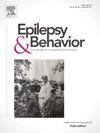儿童发热性感染相关癫痫综合征(FIRES)的临床结果比较
IF 2.3
3区 医学
Q2 BEHAVIORAL SCIENCES
引用次数: 0
摘要
背景和目的:我们评估了仅接受常规治疗与接受生物制剂和/或生酮饮食的儿童的功能、情绪和行为结局。方法回顾性分析两所儿科医院诊断为急性呼吸道感染的儿童(18岁)。根据生物制剂的可用性(从2018年起),根据两个时间段对儿童进行了分析。通过改进的兰金量表(mRS)和儿科功能独立性量表(WeeFIM)评估功能结局。攻击症状(用改良的显性攻击量表(MOAS)筛选)、注意缺陷/多动障碍(ADHD)的诊断、焦虑和抑郁也被记录下来。这些结果测量在诊断后24个月进行分析。结果30例患儿(平均8.9±4.2岁)被诊断为FIRES。术后12个月mRS中位数为2 (IQR 1-5)。在需要生物制剂和/或KD治疗的儿童中,WeeFIM评分在出院时(p = 0.053)至24个月随访时(p = 0.030)较低。攻击行为在后期(2018-2023年)更为普遍(53.5%),出院时MOAS中位数得分较高(p = 0.019),随访24个月时得分较高(p = 0.10)。在两个时间段内,观察到的儿童注意力不集中(33.3%)和情绪障碍(20%)的比例相似。攻击性出现较早(中位1.8个月,IQR 1-4.5),注意力不集中和情绪障碍出现较晚(中位4个月,IQR 1.8 - 10.5)。结论所有从火灾中恢复的儿童都需要筛查潜在的长期情绪和行为后遗症。本文补充的是(1)无论是否给予生物制剂和/或生酮饮食治疗,在fire中都观察到行为和情绪后遗症。(2)攻击症状出现得较早,而注意力不集中和情绪障碍在随访中较晚被发现。(3)所有患有fire的儿童都应进行长期情绪和行为后遗症筛查。本文章由计算机程序翻译,如有差异,请以英文原文为准。
Comparative clinical outcomes in children with Febrile Infection-Related Epilepsy Syndrome (FIRES)
Background and aims
We evaluated functional, emotional, and behavioural outcomes in children with FIRES in those who received only conventional treatments versus those who received biologics and/or ketogenic diet.
Methods
A retrospective chart review of children (<18 years) diagnosed with FIRES at two paediatric hospitals. Children were analysed according to two time periods according to availability of biologics (from 2018 onwards). Functional outcomes were assessed via modified Rankin Scale (mRS) and paediatric functional independence measure (WeeFIM). Aggression symptoms (screened with modified overt aggression scale (MOAS)), diagnoses of attention deficit/ hyperactivity disorder (ADHD), and anxiety and depression were also recorded. These outcome measures were analysed in intervals, up to 24 months post diagnosis.
Results
There were 30 children (mean age 8.9 ± 4.2 years) diagnosed with FIRES. Median mRS at 12 months post FIRES was 2 (IQR 1–5). WeeFIM score was lower at discharge (p = 0.053) to 24 months follow up (p = 0.030) in children who required biologics and/or KD. Aggression was more prevalent (53.5 %) in the latter period (2018–2023) with median MOAS scores higher at discharge (p = 0.019) and follow up at 24 months (p = 0.10). Inattention (33.3 %) and mood disorders (20 %) were observed in similar proportions of children across both time periods. Aggression appeared earlier (median 1.8 months, IQR 1–4.5) whilst inattention and mood disorder were noted later (median 4 months, IQR 1.8–10.5 and median 27 months, IQR 12 = 39 respectively).
Conclusion
All children recovering from FIRES need to be screened for potential long-term emotional and behavioural sequelae.
What this paper adds
(1) Behavioural and emotional sequelae were observed in FIRES regardless of whether biologics and/or Ketogenic Diet treatment was given.
(2) Aggression symptoms appeared earlier, whilst inattention and mood disorder were noted later during follow up.
(3) All children post FIRES should be screened for long-term emotional and behavioural sequelae.
求助全文
通过发布文献求助,成功后即可免费获取论文全文。
去求助
来源期刊

Epilepsy & Behavior
医学-行为科学
CiteScore
5.40
自引率
15.40%
发文量
385
审稿时长
43 days
期刊介绍:
Epilepsy & Behavior is the fastest-growing international journal uniquely devoted to the rapid dissemination of the most current information available on the behavioral aspects of seizures and epilepsy.
Epilepsy & Behavior presents original peer-reviewed articles based on laboratory and clinical research. Topics are drawn from a variety of fields, including clinical neurology, neurosurgery, neuropsychiatry, neuropsychology, neurophysiology, neuropharmacology, and neuroimaging.
From September 2012 Epilepsy & Behavior stopped accepting Case Reports for publication in the journal. From this date authors who submit to Epilepsy & Behavior will be offered a transfer or asked to resubmit their Case Reports to its new sister journal, Epilepsy & Behavior Case Reports.
 求助内容:
求助内容: 应助结果提醒方式:
应助结果提醒方式:


